ITECH1102 Networking and Security: Layer & Cloud Analysis Report
VerifiedAdded on 2023/04/25
|6
|1503
|465
Report
AI Summary
This report provides a comprehensive analysis of the Data Link Layer, Transport Layer, and Cloud Mobile, key components in networking. It details the functions of the Data Link Layer, including framing, flow control, physical addressing, access control, and error control, highlighting its role in ensuring reliable data transmission. The analysis of the Transport Layer covers service point addressing, connection control, segmentation, reassembling, and error and flow control, emphasizing its function in end-to-end communication. Furthermore, the report explores Cloud Computing, defining its characteristics such as self-service provisioning, pay-per-use, workload flexibility, and migration adaptability. The document concludes by summarizing the importance and interrelation of these networking concepts. Desklib offers a wealth of similar solved assignments and past papers to aid students in their studies.
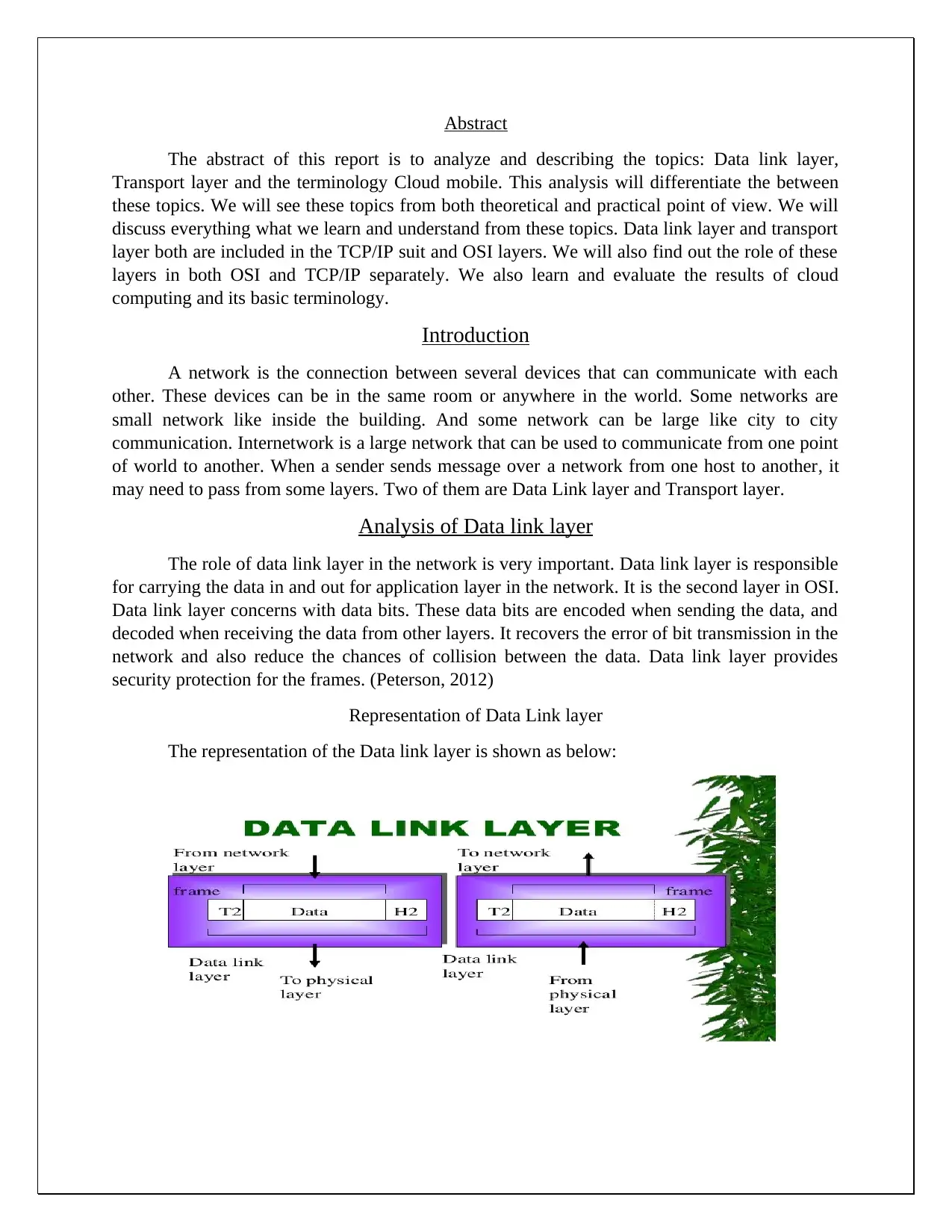
Abstract
The abstract of this report is to analyze and describing the topics: Data link layer,
Transport layer and the terminology Cloud mobile. This analysis will differentiate the between
these topics. We will see these topics from both theoretical and practical point of view. We will
discuss everything what we learn and understand from these topics. Data link layer and transport
layer both are included in the TCP/IP suit and OSI layers. We will also find out the role of these
layers in both OSI and TCP/IP separately. We also learn and evaluate the results of cloud
computing and its basic terminology.
Introduction
A network is the connection between several devices that can communicate with each
other. These devices can be in the same room or anywhere in the world. Some networks are
small network like inside the building. And some network can be large like city to city
communication. Internetwork is a large network that can be used to communicate from one point
of world to another. When a sender sends message over a network from one host to another, it
may need to pass from some layers. Two of them are Data Link layer and Transport layer.
Analysis of Data link layer
The role of data link layer in the network is very important. Data link layer is responsible
for carrying the data in and out for application layer in the network. It is the second layer in OSI.
Data link layer concerns with data bits. These data bits are encoded when sending the data, and
decoded when receiving the data from other layers. It recovers the error of bit transmission in the
network and also reduce the chances of collision between the data. Data link layer provides
security protection for the frames. (Peterson, 2012)
Representation of Data Link layer
The representation of the Data link layer is shown as below:
The abstract of this report is to analyze and describing the topics: Data link layer,
Transport layer and the terminology Cloud mobile. This analysis will differentiate the between
these topics. We will see these topics from both theoretical and practical point of view. We will
discuss everything what we learn and understand from these topics. Data link layer and transport
layer both are included in the TCP/IP suit and OSI layers. We will also find out the role of these
layers in both OSI and TCP/IP separately. We also learn and evaluate the results of cloud
computing and its basic terminology.
Introduction
A network is the connection between several devices that can communicate with each
other. These devices can be in the same room or anywhere in the world. Some networks are
small network like inside the building. And some network can be large like city to city
communication. Internetwork is a large network that can be used to communicate from one point
of world to another. When a sender sends message over a network from one host to another, it
may need to pass from some layers. Two of them are Data Link layer and Transport layer.
Analysis of Data link layer
The role of data link layer in the network is very important. Data link layer is responsible
for carrying the data in and out for application layer in the network. It is the second layer in OSI.
Data link layer concerns with data bits. These data bits are encoded when sending the data, and
decoded when receiving the data from other layers. It recovers the error of bit transmission in the
network and also reduce the chances of collision between the data. Data link layer provides
security protection for the frames. (Peterson, 2012)
Representation of Data Link layer
The representation of the Data link layer is shown as below:
Paraphrase This Document
Need a fresh take? Get an instant paraphrase of this document with our AI Paraphraser
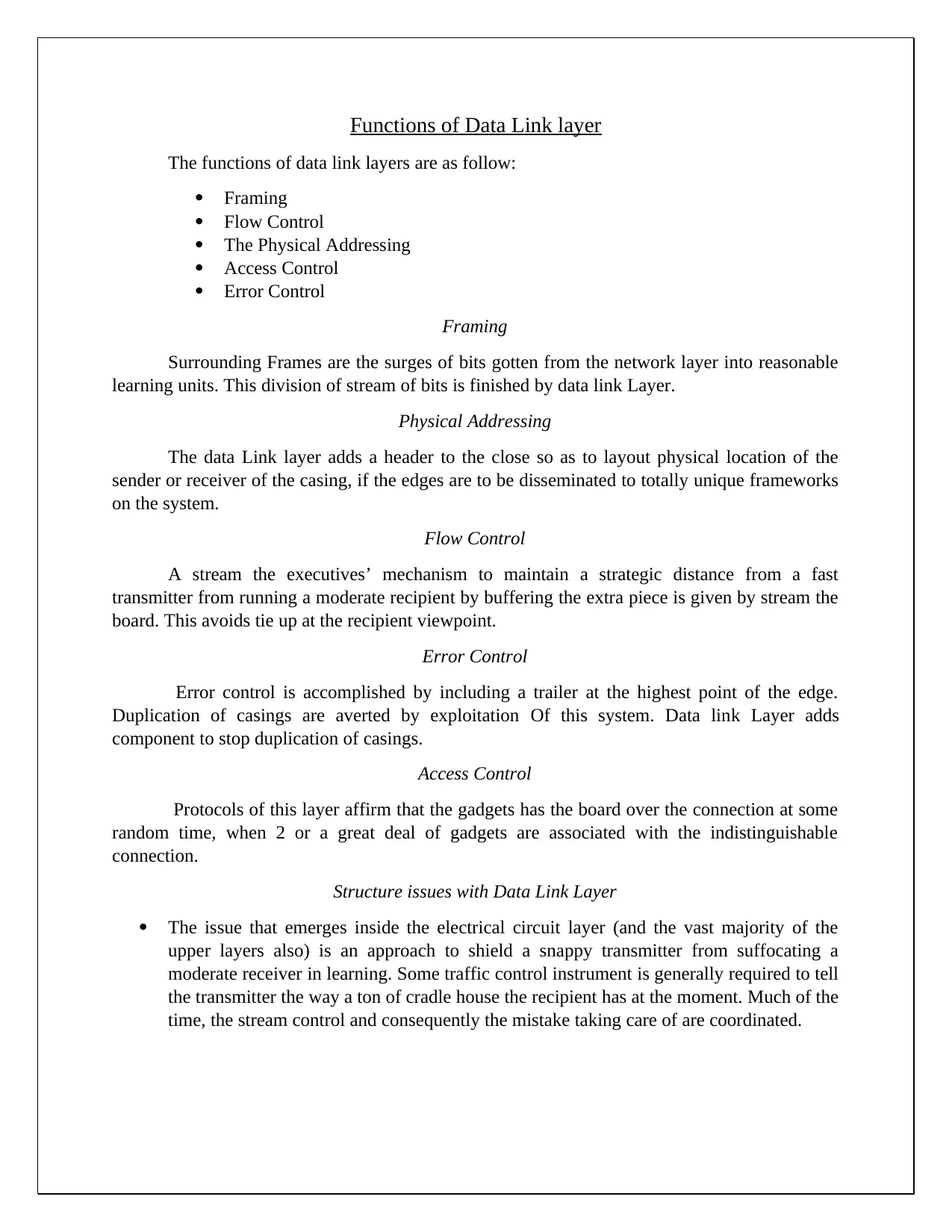
Functions of Data Link layer
The functions of data link layers are as follow:
Framing
Flow Control
The Physical Addressing
Access Control
Error Control
Framing
Surrounding Frames are the surges of bits gotten from the network layer into reasonable
learning units. This division of stream of bits is finished by data link Layer.
Physical Addressing
The data Link layer adds a header to the close so as to layout physical location of the
sender or receiver of the casing, if the edges are to be disseminated to totally unique frameworks
on the system.
Flow Control
A stream the executives’ mechanism to maintain a strategic distance from a fast
transmitter from running a moderate recipient by buffering the extra piece is given by stream the
board. This avoids tie up at the recipient viewpoint.
Error Control
Error control is accomplished by including a trailer at the highest point of the edge.
Duplication of casings are averted by exploitation Of this system. Data link Layer adds
component to stop duplication of casings.
Access Control
Protocols of this layer affirm that the gadgets has the board over the connection at some
random time, when 2 or a great deal of gadgets are associated with the indistinguishable
connection.
Structure issues with Data Link Layer
The issue that emerges inside the electrical circuit layer (and the vast majority of the
upper layers also) is an approach to shield a snappy transmitter from suffocating a
moderate receiver in learning. Some traffic control instrument is generally required to tell
the transmitter the way a ton of cradle house the recipient has at the moment. Much of the
time, the stream control and consequently the mistake taking care of are coordinated.
The functions of data link layers are as follow:
Framing
Flow Control
The Physical Addressing
Access Control
Error Control
Framing
Surrounding Frames are the surges of bits gotten from the network layer into reasonable
learning units. This division of stream of bits is finished by data link Layer.
Physical Addressing
The data Link layer adds a header to the close so as to layout physical location of the
sender or receiver of the casing, if the edges are to be disseminated to totally unique frameworks
on the system.
Flow Control
A stream the executives’ mechanism to maintain a strategic distance from a fast
transmitter from running a moderate recipient by buffering the extra piece is given by stream the
board. This avoids tie up at the recipient viewpoint.
Error Control
Error control is accomplished by including a trailer at the highest point of the edge.
Duplication of casings are averted by exploitation Of this system. Data link Layer adds
component to stop duplication of casings.
Access Control
Protocols of this layer affirm that the gadgets has the board over the connection at some
random time, when 2 or a great deal of gadgets are associated with the indistinguishable
connection.
Structure issues with Data Link Layer
The issue that emerges inside the electrical circuit layer (and the vast majority of the
upper layers also) is an approach to shield a snappy transmitter from suffocating a
moderate receiver in learning. Some traffic control instrument is generally required to tell
the transmitter the way a ton of cradle house the recipient has at the moment. Much of the
time, the stream control and consequently the mistake taking care of are coordinated.
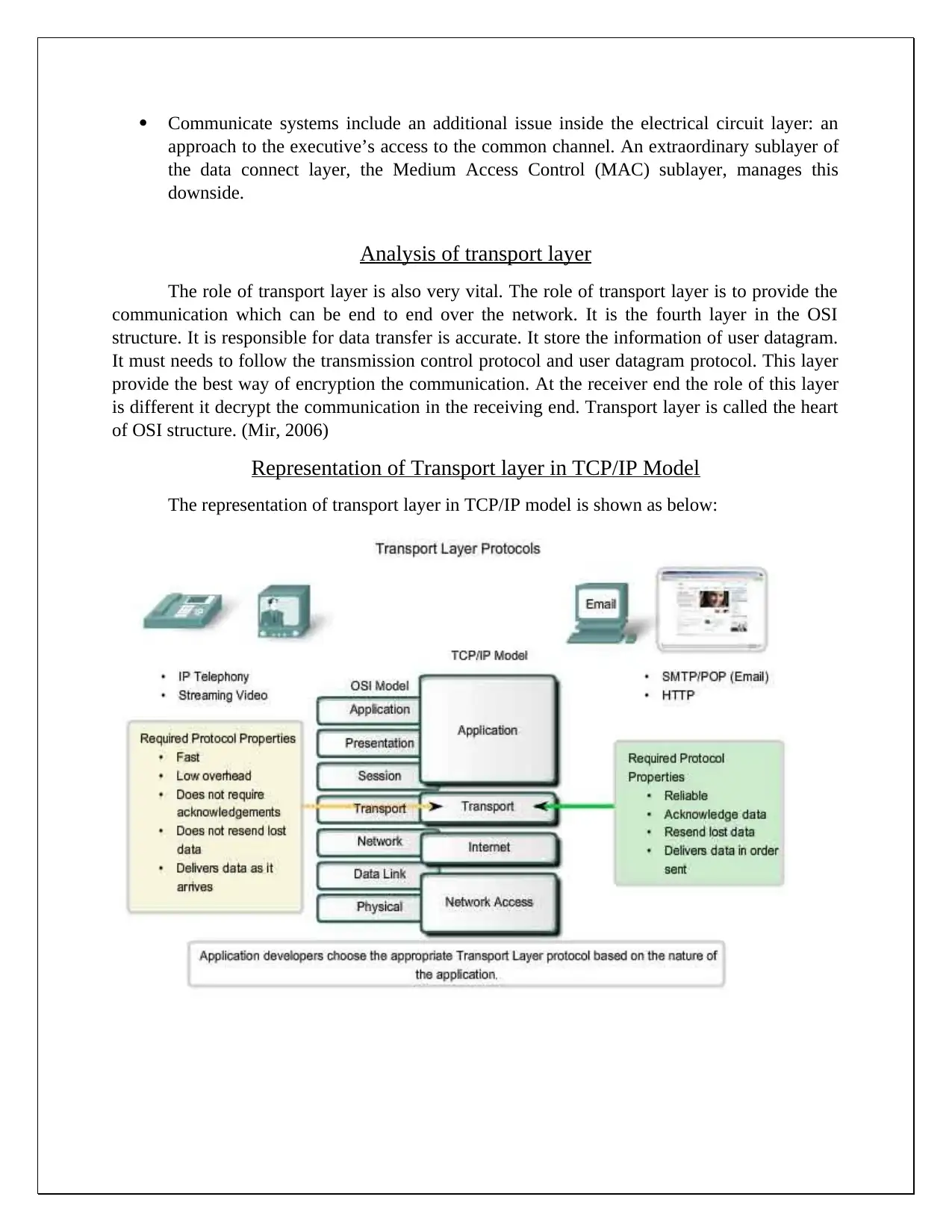
Communicate systems include an additional issue inside the electrical circuit layer: an
approach to the executive’s access to the common channel. An extraordinary sublayer of
the data connect layer, the Medium Access Control (MAC) sublayer, manages this
downside.
Analysis of transport layer
The role of transport layer is also very vital. The role of transport layer is to provide the
communication which can be end to end over the network. It is the fourth layer in the OSI
structure. It is responsible for data transfer is accurate. It store the information of user datagram.
It must needs to follow the transmission control protocol and user datagram protocol. This layer
provide the best way of encryption the communication. At the receiver end the role of this layer
is different it decrypt the communication in the receiving end. Transport layer is called the heart
of OSI structure. (Mir, 2006)
Representation of Transport layer in TCP/IP Model
The representation of transport layer in TCP/IP model is shown as below:
approach to the executive’s access to the common channel. An extraordinary sublayer of
the data connect layer, the Medium Access Control (MAC) sublayer, manages this
downside.
Analysis of transport layer
The role of transport layer is also very vital. The role of transport layer is to provide the
communication which can be end to end over the network. It is the fourth layer in the OSI
structure. It is responsible for data transfer is accurate. It store the information of user datagram.
It must needs to follow the transmission control protocol and user datagram protocol. This layer
provide the best way of encryption the communication. At the receiver end the role of this layer
is different it decrypt the communication in the receiving end. Transport layer is called the heart
of OSI structure. (Mir, 2006)
Representation of Transport layer in TCP/IP Model
The representation of transport layer in TCP/IP model is shown as below:
⊘ This is a preview!⊘
Do you want full access?
Subscribe today to unlock all pages.

Trusted by 1+ million students worldwide
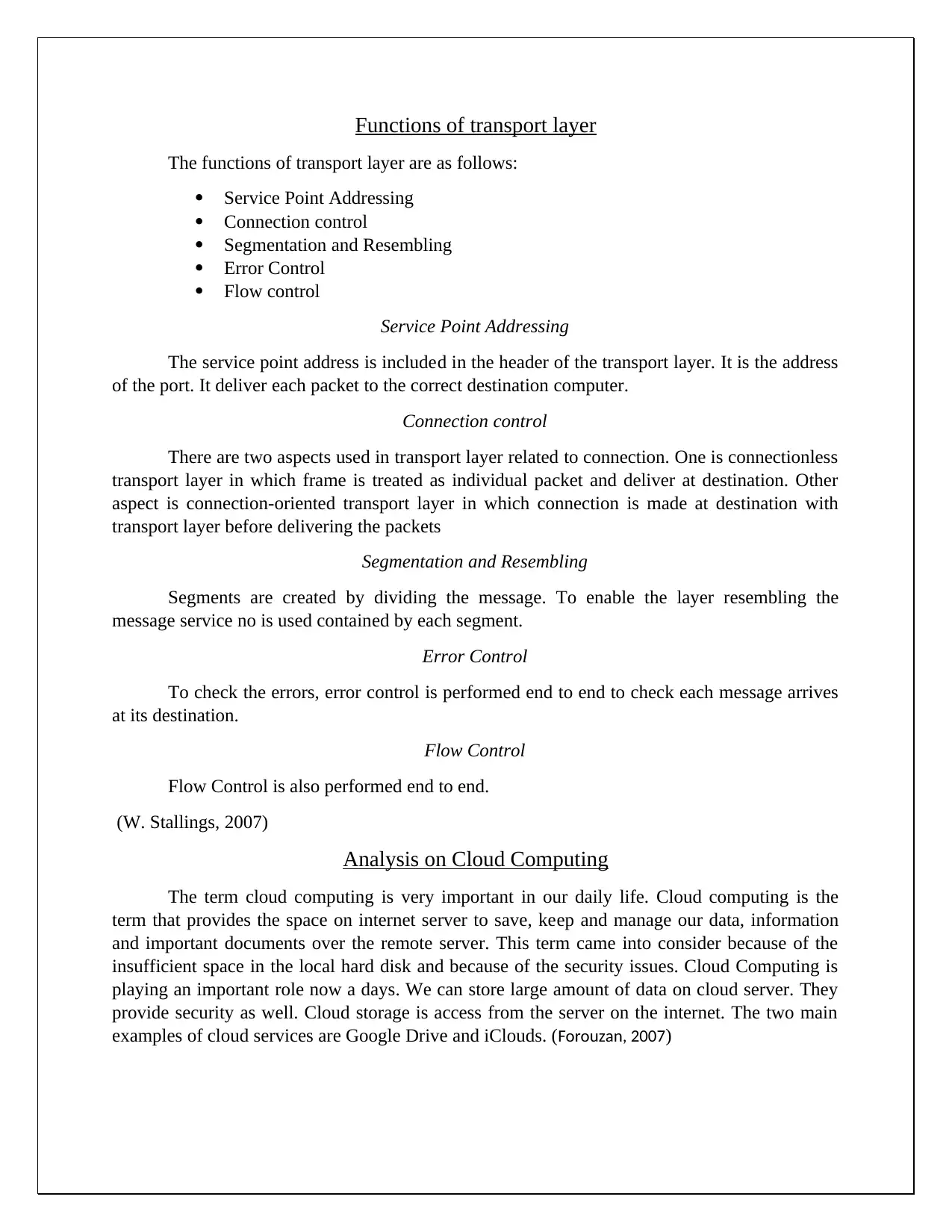
Functions of transport layer
The functions of transport layer are as follows:
Service Point Addressing
Connection control
Segmentation and Resembling
Error Control
Flow control
Service Point Addressing
The service point address is included in the header of the transport layer. It is the address
of the port. It deliver each packet to the correct destination computer.
Connection control
There are two aspects used in transport layer related to connection. One is connectionless
transport layer in which frame is treated as individual packet and deliver at destination. Other
aspect is connection-oriented transport layer in which connection is made at destination with
transport layer before delivering the packets
Segmentation and Resembling
Segments are created by dividing the message. To enable the layer resembling the
message service no is used contained by each segment.
Error Control
To check the errors, error control is performed end to end to check each message arrives
at its destination.
Flow Control
Flow Control is also performed end to end.
(W. Stallings, 2007)
Analysis on Cloud Computing
The term cloud computing is very important in our daily life. Cloud computing is the
term that provides the space on internet server to save, keep and manage our data, information
and important documents over the remote server. This term came into consider because of the
insufficient space in the local hard disk and because of the security issues. Cloud Computing is
playing an important role now a days. We can store large amount of data on cloud server. They
provide security as well. Cloud storage is access from the server on the internet. The two main
examples of cloud services are Google Drive and iClouds. (Forouzan, 2007)
The functions of transport layer are as follows:
Service Point Addressing
Connection control
Segmentation and Resembling
Error Control
Flow control
Service Point Addressing
The service point address is included in the header of the transport layer. It is the address
of the port. It deliver each packet to the correct destination computer.
Connection control
There are two aspects used in transport layer related to connection. One is connectionless
transport layer in which frame is treated as individual packet and deliver at destination. Other
aspect is connection-oriented transport layer in which connection is made at destination with
transport layer before delivering the packets
Segmentation and Resembling
Segments are created by dividing the message. To enable the layer resembling the
message service no is used contained by each segment.
Error Control
To check the errors, error control is performed end to end to check each message arrives
at its destination.
Flow Control
Flow Control is also performed end to end.
(W. Stallings, 2007)
Analysis on Cloud Computing
The term cloud computing is very important in our daily life. Cloud computing is the
term that provides the space on internet server to save, keep and manage our data, information
and important documents over the remote server. This term came into consider because of the
insufficient space in the local hard disk and because of the security issues. Cloud Computing is
playing an important role now a days. We can store large amount of data on cloud server. They
provide security as well. Cloud storage is access from the server on the internet. The two main
examples of cloud services are Google Drive and iClouds. (Forouzan, 2007)
Paraphrase This Document
Need a fresh take? Get an instant paraphrase of this document with our AI Paraphraser
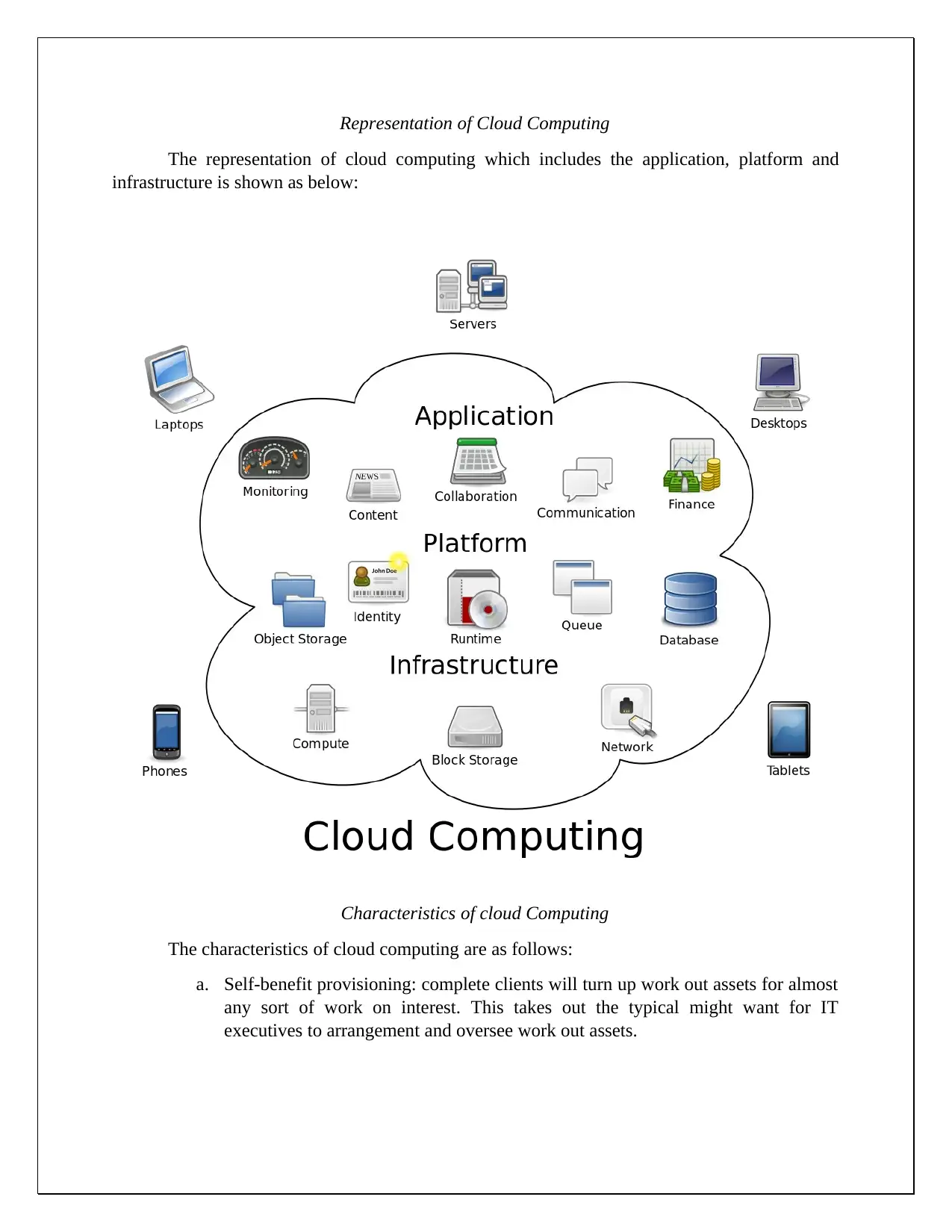
Representation of Cloud Computing
The representation of cloud computing which includes the application, platform and
infrastructure is shown as below:
Characteristics of cloud Computing
The characteristics of cloud computing are as follows:
a. Self-benefit provisioning: complete clients will turn up work out assets for almost
any sort of work on interest. This takes out the typical might want for IT
executives to arrangement and oversee work out assets.
The representation of cloud computing which includes the application, platform and
infrastructure is shown as below:
Characteristics of cloud Computing
The characteristics of cloud computing are as follows:
a. Self-benefit provisioning: complete clients will turn up work out assets for almost
any sort of work on interest. This takes out the typical might want for IT
executives to arrangement and oversee work out assets.
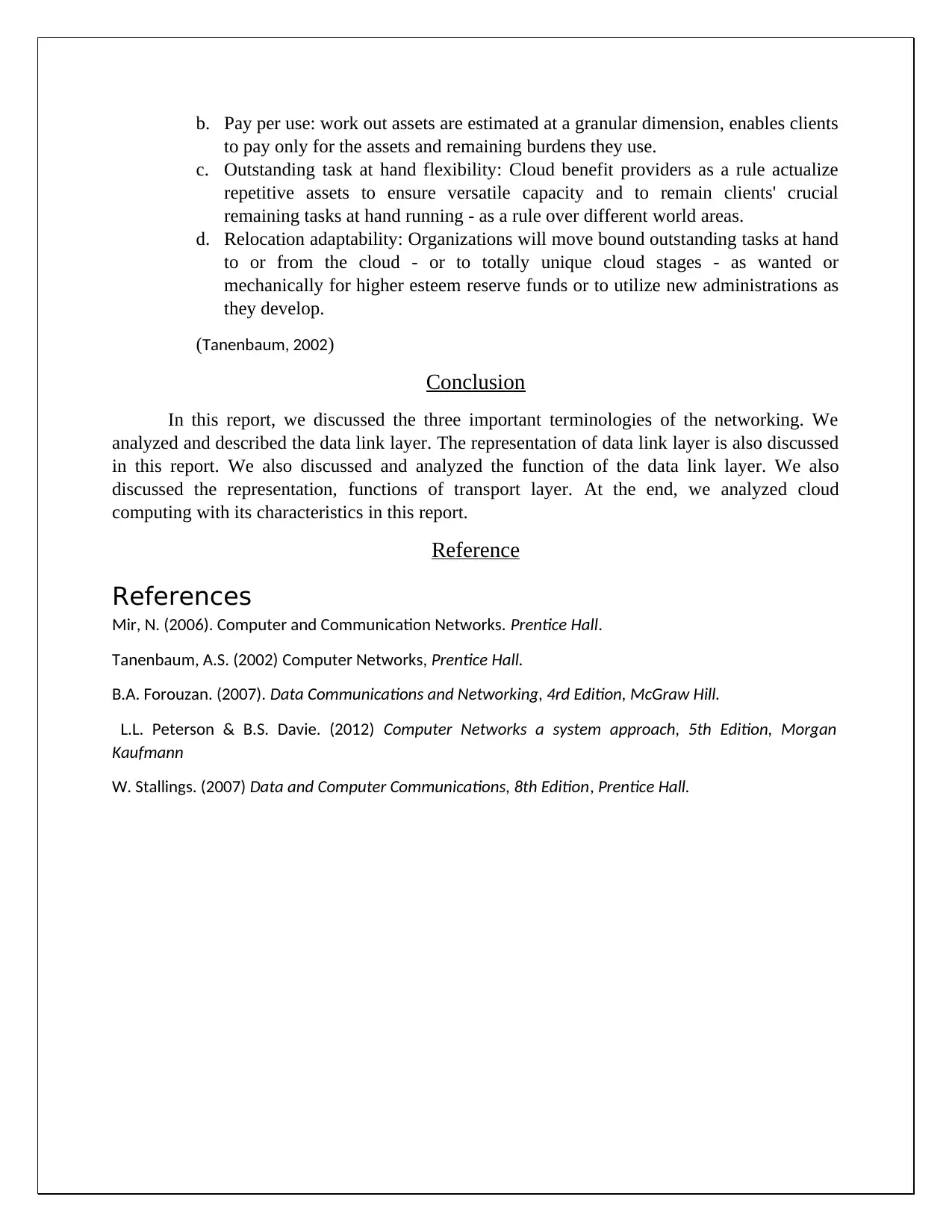
b. Pay per use: work out assets are estimated at a granular dimension, enables clients
to pay only for the assets and remaining burdens they use.
c. Outstanding task at hand flexibility: Cloud benefit providers as a rule actualize
repetitive assets to ensure versatile capacity and to remain clients' crucial
remaining tasks at hand running - as a rule over different world areas.
d. Relocation adaptability: Organizations will move bound outstanding tasks at hand
to or from the cloud - or to totally unique cloud stages - as wanted or
mechanically for higher esteem reserve funds or to utilize new administrations as
they develop.
(Tanenbaum, 2002)
Conclusion
In this report, we discussed the three important terminologies of the networking. We
analyzed and described the data link layer. The representation of data link layer is also discussed
in this report. We also discussed and analyzed the function of the data link layer. We also
discussed the representation, functions of transport layer. At the end, we analyzed cloud
computing with its characteristics in this report.
Reference
References
Mir, N. (2006). Computer and Communication Networks. Prentice Hall.
Tanenbaum, A.S. (2002) Computer Networks, Prentice Hall.
B.A. Forouzan. (2007). Data Communications and Networking, 4rd Edition, McGraw Hill.
L.L. Peterson & B.S. Davie. (2012) Computer Networks a system approach, 5th Edition, Morgan
Kaufmann
W. Stallings. (2007) Data and Computer Communications, 8th Edition, Prentice Hall.
to pay only for the assets and remaining burdens they use.
c. Outstanding task at hand flexibility: Cloud benefit providers as a rule actualize
repetitive assets to ensure versatile capacity and to remain clients' crucial
remaining tasks at hand running - as a rule over different world areas.
d. Relocation adaptability: Organizations will move bound outstanding tasks at hand
to or from the cloud - or to totally unique cloud stages - as wanted or
mechanically for higher esteem reserve funds or to utilize new administrations as
they develop.
(Tanenbaum, 2002)
Conclusion
In this report, we discussed the three important terminologies of the networking. We
analyzed and described the data link layer. The representation of data link layer is also discussed
in this report. We also discussed and analyzed the function of the data link layer. We also
discussed the representation, functions of transport layer. At the end, we analyzed cloud
computing with its characteristics in this report.
Reference
References
Mir, N. (2006). Computer and Communication Networks. Prentice Hall.
Tanenbaum, A.S. (2002) Computer Networks, Prentice Hall.
B.A. Forouzan. (2007). Data Communications and Networking, 4rd Edition, McGraw Hill.
L.L. Peterson & B.S. Davie. (2012) Computer Networks a system approach, 5th Edition, Morgan
Kaufmann
W. Stallings. (2007) Data and Computer Communications, 8th Edition, Prentice Hall.
⊘ This is a preview!⊘
Do you want full access?
Subscribe today to unlock all pages.

Trusted by 1+ million students worldwide
1 out of 6
Related Documents
Your All-in-One AI-Powered Toolkit for Academic Success.
+13062052269
info@desklib.com
Available 24*7 on WhatsApp / Email
![[object Object]](/_next/static/media/star-bottom.7253800d.svg)
Unlock your academic potential
Copyright © 2020–2025 A2Z Services. All Rights Reserved. Developed and managed by ZUCOL.



